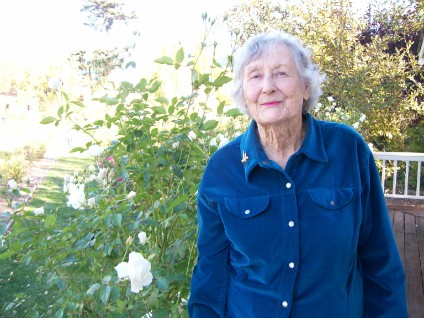Our Founder Miriam Wilkins
Miriam C. (Walsh) Wilkins
d. November 6, 2009 at 91 years
Two sentences changed the rose world - hard to believe but it is true.
In January, 1974, a short ad in the American Rose Society magazine started a movement that is still gaining speed today.
"Those who love old roses are asked to write to M. Wilkins, 925 Galvin Drive, El Cerrito, CA 94530. Objective: share information, unobtainable varieties, and enthusiasm."

She had grown tired of reading of nothing but the new roses, especially those without any fragrance or individual grace.
The lady who wrote these lines was Miriam Wilkins, until her death in November 2009, still a resident at that address, and still promoting the cause of old roses. The city where she spent most of her life honored her recently for her dedication. Her photo and her work are now recorded in the city's Wall of Fame.
When she wrote her ad, most rose growers, nurseries, and public gardens were interested in the new roses, mostly the still popular Hybrid Teas. What she said she wanted was "to share with others the history, beauty, landscaping potential and low-care attributes of the roses that have survived for so many years - or even centuries - despite being ignored by the major nurseries and rosarians." In addition, she missed the wonderful perfume of heirloom roses.
Those "unobtainable varieties" of the time are now available at many nurseries throughout the world. The gardening public for years had been sold with the idea that a rose should rebloom - and many of the heritage ones bloom only once. That it still the hardest prejudice to overcome, but Wilkins must be given credit for the success of her work.
She was born 91 years ago in El Cerrito, a city north of Berkeley, California, and where she was an elementary school teacher and raised her four children, who have been a great support in her work. Every year on the Sunday after Mother's Day she held her Celebration of Old Roses in the community center, with hundreds and sometimes thousands of rose lovers congregating to look at, smell, and buy the hundreds of plants on display. She began her Heritage Rose Group so that others could join her in promoting them to the public; her bi-annual newsletter was published for 25 years and is now edited by Joanie Helgeson.
Her ideas caught on, not only gardeners but with a few nurseries, at first, and then many joined the cause, not only in the U.S. but overseas as well. At the close of WWII only one nursery in the world was selling the heirloom plants. Her newsletter was subscribed to by others overseas, where the movement now has organizations and publications in France, England, New Zealand, and Australia. International Heritage Rose conferences are held every other year, the last one in Paris. No date has been set for the net one.
Anyone who has met or known Wilkins over the years can tell you she was marked by her warmth, her knowledge, and her determination to spread the word. "A landscape full of modern roses can be monotonous for their characteristics do not differ that much. However, hybridizers now are varying form and habit; perhaps we have convinced gardeners that a muddled shape can equal the modern ones if that variety is healthy and fragrant," she says.
That "muddled" term refers to the large, full, graceful form of such roses as the Albas, Bourbons, Damasks, Mosses, among others. The species or wild roses are also treasured by her and others, though they are not always adaptable to smaller gardens.
In her own garden she grew hundreds of shrubs and climbers, drawing rosarians from faraway places to enjoy the fragrance and the beauty of the roses that overflow the paths and spill into neighbors' gardens. A BBC film, innumerable books and articles have told the story.